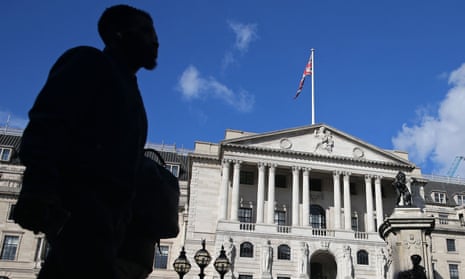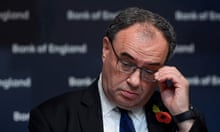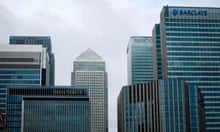Pension fund managers breathed a cautious sigh of relief on Thursday morning. After days of market turmoil, the Bank of England’s £65bn emergency intervention the day before had – at least temporarily – stabilised UK government bond prices, supported the pound, and halted a pension fund selloff that threatened to spark a deeper crisis across the City.
“After 35 years in the industry, I’d never seen anything like it,” Luke Hickmore, a fund manager at investment company Abrdn said. However, markets were now “a lot calmer”.
“It’s good to finally see the UK [bond] market moving at a similar pace as Europe.”
No one had predicted the chaos that followed Kwasi Kwarteng’s mini-budget last Friday. His policies were initially cast as City-friendly, with banks and insurers among the biggest beneficiaries of an allegedly pro-growth agenda, focused on sweeping tax cuts and deregulation across the financial sector.
But within hours, markets had given a far harsher verdict amid fears that the chancellor had failed to fund those reforms, creating uncertainty about the stability of the UK’s economic forecasts. Sterling exchange rates tumbled, hitting record lows by Monday, while UK government bond prices plunged.
Yet while headlines understandably focused on the immediate impact on consumers – as mortgage offers disappeared and borrowing rates started to rise – a storm was brewing in a little-known corner of the pensions market that would eventually require the central bank’s massive intervention to quell it.
The problem centred on the use of niche financial products offered by investment banks to pension funds that are trying to manage or hedge their risks. Those products – known as liability-driven investing, or LDIs – help offset liabilities and risks on pension funds’ books.
However, as asset prices slumped over the week – including UK government bonds, or gilts – those banks required more collateral to offset the pension funds’ liabilities, forcing the funds to dump assets and raise cash at short notice.
Quick GuideGlossary of key terms to explain UK economic turmoil
Show
Monetary policy
The job of the Bank of England, which since 1997 has had the statutory task of hitting the inflation target set by the government – currently 2%.
Fiscal policy
The Treasury is responsible for fiscal policy, which involves taxation, public spending and the relationship between the two. 'Fiscal easing' is when plans for tax cuts not are not matched by planned spending cuts.
Budget deficit
The gap between what the government spends and its tax revenues
Government debt
The sum of annual budget deficits – and the less frequent surpluses – over time.
Government bonds
In the UK these are known as gilts, and are a way the state borrows to finance its spending. The fact that governments guarantee to pay investors back means they are traditionally seen as low risk. Bonds mature over different timescales, including one year, five years, 10 years and 30 years.
Bond yields and prices
Most bonds are issued at a fixed interest rate and the yield is the return on the capital invested. When the Bank of England cuts interest rates, the fixed return on gilts becomes more attractive and prices rise. However, when interest rates rise gilts become less attractive and prices fall. Therefore when bond prices fall, bond yields rise, and vice versa.
Short- and long-term interest rates
Short-term interest rates are set by the Bank of England’s MPC, which meets eight times a year. Long-term interest rates move up and down with fluctuations in gilt yields, with the most important the yield on 10-year gilts. Long-term interest rates affect the cost of fixed-rate mortgages, overdrafts and credit card borrowing.
Quantitative easing and quantitative tightening
When the Bank of England buys bonds it is called quantitative easing (QE), because the Bank pays for the bonds it is purchasing by creating electronic money, which it hopes will find its way into the financial system and the wider economy. Quantitative tightening (QT) has the opposite effect. It reduces the money supply through sales of assets.
Pension funds and the bond markets
Pension funds tend to be big holders of bonds because they provide a relatively risk-free way of guaranteeing payouts to retirees over many decades. Movements in bond prices tend to be relatively gradual, but pension funds still take out insurance – hedging policies – as protection to limit their exposure. A rapid drop in gilt prices can threaten to make these hedges ineffective.
Margin calls
Buying on margin is where an investor or institution buys an asset through a downpayment and borrows money to cover the rest of the cost. The upside of margin trading is that it allows big bets and higher returns when times are good. But investors have to provide collateral to cover losses when times are bad. In times of stress they are subject to margin calls, where they have to find additional collateral, often very quickly.
Doom loop
This is where a financial crisis starts to feed on itself, because institutions are forced into a fire sale of their assets to meet margin calls. If pension funds are selling gilts into a falling market, the result is lower gilt prices, higher gilt yields, bigger losses and further margin calls.
Fiscal dominance
This is where the Bank of England is prevented from taking the action it thinks is necessary to combat inflation because of the size of the budget deficit being run by the Treasury. Fiscal dominance could take two forms: the Bank might keep interest rates lower than they would otherwise be, in order to reduce the government’s interest payments on its borrowing, or it might involve covering government borrowing by buying more gilts.
Larry Elliott Economics editor
Experts say pension funds were not at immediate risk of insolvency. However, uncertainty over the scale of the selloff – and how long it would run – raised concerns about a “doom loop”, where asset sales depressed prices further, resulting in higher collateral calls, which then sparked further sales.
And so the demands went down the chain: from banks needing collateral, to investment managers, who had to pass the message on to workplace pension fund clients they worked for, as gilt prices continued to plunge.
Legal & General, one of the UK’s largest pension and insurance firms, was one of the first to pass on collateral calls to its pension funds clients on Sunday evening. From there, rumours started to spread about the extent of the problem, and estimates about the size of the collateral calls were growing.
One of the notes circulating among fund managers was from Goldman Sachs’ credit sales team, which suggested that UK pension funds – which collectively hold about £1.8tn worth of assets – may be forced to stump up as much as £550bn worth of collateral to cover their contracts if gilt prices continued to plunge.
after newsletter promotion
By Wednesday morning, the asset manager BlackRock was writing to pension fund clients, saying it was closely “monitoring” funds that were at risk of having their assets “exhausted” as a result of their exposure to LDIs.
It was the speed of the market moves that were the problem. Experts said that if bond yields – which move inversely to prices – had risen more gradually, the problem would have been manageable. “But when you have shock moves where you get collateral calls, that bleeds into other assets and results in contagion,” Hickmore said.
It was unclear how pension funds would raise enough money at increasingly short notice. That meant the selloff could spread to assets including stocks and corporate bonds, playing further into doom loop fears.
“That would more than ripple,” the former Bank of England governor Mark Carney told the BBC on Thursday. “I mean, it would cascade through financial markets, to the counter-parties – the people those pension funds were dealing with,” he added, referring to the investment banks and clearing banks that offered the contracts.
“That’s why the Bank of England stepped in, in a temporary fashion, to right the ship … If the bank had done nothing, I think we would have had further moves up in government bond yields, and potentially some of these pension funds unable to make short-term obligations.”
However, Carney stressed that defined benefit pension schemes – which were at the centre of the selloff – were “fine overall” and “had enough assets to pay off” future pensions.
Simon Wolfson, chief executive of retailer Next, said there were still questions to be answered about the plumbing of the pension fund system and, in particular, the use of LDIs.
The chief executive said the retailer’s own pension scheme had refused to use LDIs amid fears that could lead to increased risk. He said the company’s treasurer had even written to the Bank of England several years earlier to warn about the impact the contracts could have on financial stability.
Wolfson said LDIs were just an “extreme example” of a general shift towards investing in bonds as a way to reduce risk, which had “actually created more risk”.
The Bank of England has promised to put forward up to £65bn to buy bonds over 13 working days – working out to an average of about £5bn a day. The fact that the central bank only spent £1bn to shore up markets on Wednesday seemed to signal that the problem was containable.
But with bond yields back on the rise by Thursday afternoon, attention will be laser-focused on the size of Bank’s purchases, amid concerns that further intervention may be needed beyond mid-October
Some optimism remains, though: if Kwarteng manages to push out an independent assessment of the budget by the Office for Budget Responsibility, and prove his policies are fully costed without requiring major cuts to public services, fund managers could hoover up underpriced assets at a clip.
“If all is calm,” Hickmore said. “We’ll all have the best buying opportunity for a decade.”










